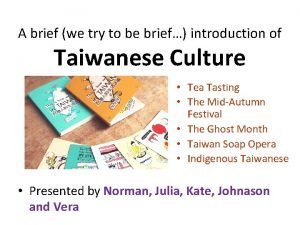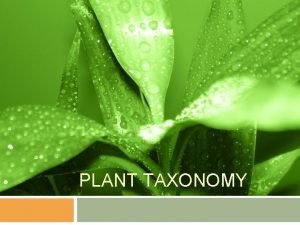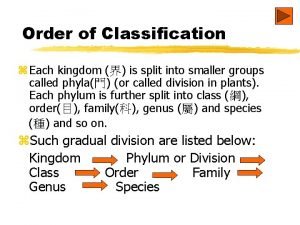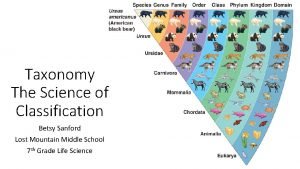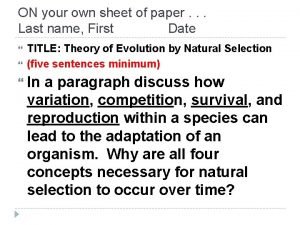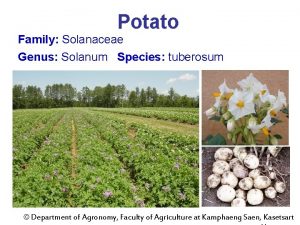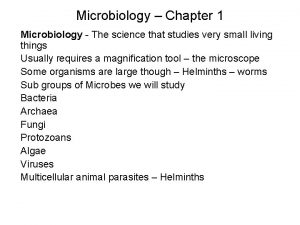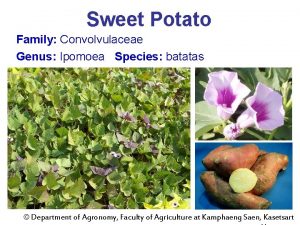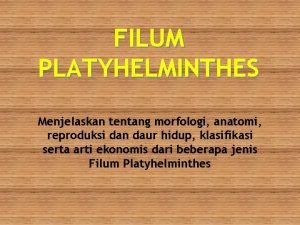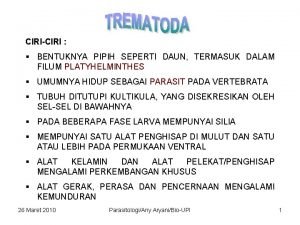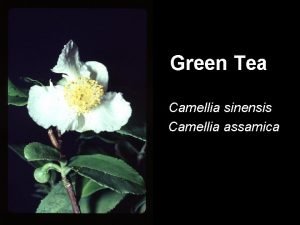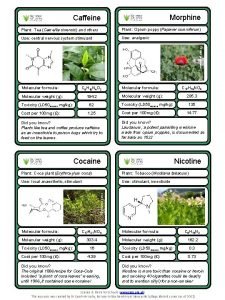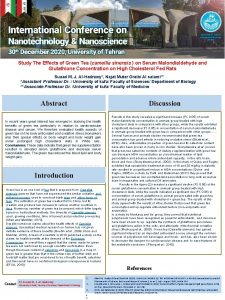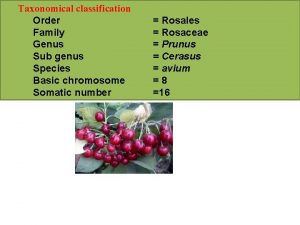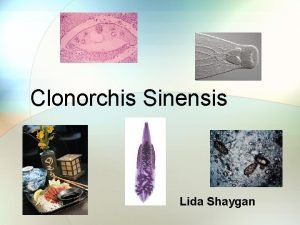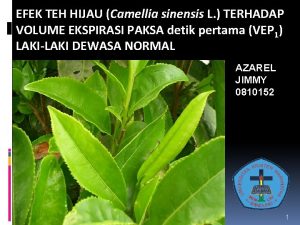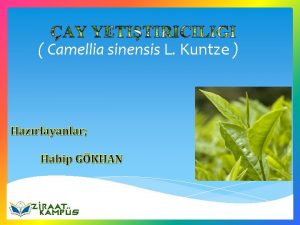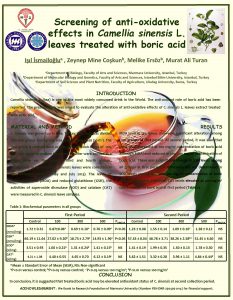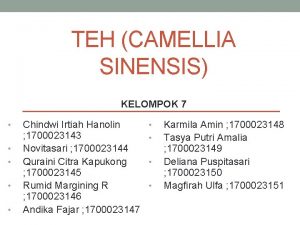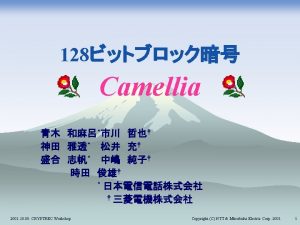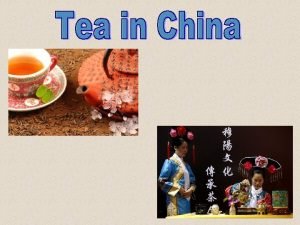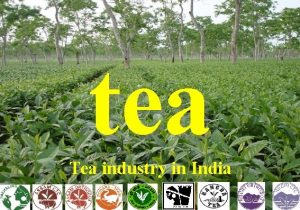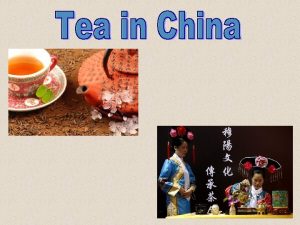TEA Camellia sinensis Family Theaceae Genus Camellia Species



































- Slides: 35

TEA - Camellia sinensis Family - Theaceae Genus - Camellia Species - sinensis

Related Plants • Ornamental Camellias Tropical Horticulture - Texas A&M University

Groups of Tea • China type - C. sinensis var. sinensis – Northern slope of the Himalayan Mts – Elevated altitudes, semi-humid forest – Bush with small erect leaves with many serrations – Flowers are borne singly – Greater tolerance to drought and low temp. – Main tea produced in China and Japan Tropical Horticulture - Texas A&M University

Groups of Tea • Assam type - C. sinensis var. assamica – Southern slopes of the Himalayan Mts – Found in humid dense forest – Tree – Leaves are larger with less serrations, less erect, and tend to droop at tips – Leaves lighter green color – Flower in clusters of 2 -4 Tropical Horticulture - Texas A&M University

Origin and Domestication of Tea Assam China 1930 s 1833 Trade with Europe 1600 s Tropical Horticulture - Texas A&M University

Tea Domestication • China type domesticated in south China – 4000 years ago? – Spread throughout China and Japan • Trading with Europe beginning in early 1600 s – Earliest maritime explorations by the Portuguese and Dutch – England enters trade with East India Co in mid to late 1600 s • East India Trade Co monopoly on tea trade ends in 1833 Tropical Horticulture - Texas A&M University

Tea Domestication • Tea growing in India investigated – Seed of China type were planted various locations – Grew best in Assam, NE India - so developed plantations – Tea-like plants grew wild throughout forest in this area - these were the Assam type tea – Initial plantings were mixtures of China and Assam tea plants • Outcrossing plants • Seed propagation • Hybrid tea populations were developed Tropical Horticulture - Texas A&M University

Tea Domestication • Assam region initial area of domestication of Assam tea – Late 1800 s • South India • Sri Lanka (esp. after rust destroyed the coffee industry) • Java and Indonesia – 1930 s • Equatorial highlands of Central and East Africa • Current Assam tea is a hybrid type derived from the initial mixed plantings in NE India Tropical Horticulture - Texas A&M University

Origin and Domestication of Tea Assam China 1930 s Tropical Horticulture - Texas A&M University 1833

Tea Production Increasing By weight 50% total production of coffee Tropical Horticulture - Texas A&M University

Tea Production Much of production consumed locally Tropical Horticulture - Texas A&M University

Tea Importations Much of production consumed locally Tropical Horticulture - Texas A&M University

The Tea Plant Perennial evergreen bush/tree Harvest young leaves Tropical Horticulture - Texas A&M University

The Tea Plant • Understorey trees • Adaptation – Temperature • 18 -30°C • Leaf growth stops – Below 13°C – Above 35°C – Shoot replacement cycle related to temp. • Equatorial region – Grown in highlands (1000 -3000 m) – At low latitude/altitude need shade for best growth (Assam type) – Rainfall – Soil type Tropical Horticulture - Texas A&M University

The Tea Plant • Understorey trees • Adaptation – Rainfall • 1150 mm if evenly distributed – Soil type • Acid soils (p. H 4. 0 to 5. 6) • Good drainage • Good water holding capacity Tropical Horticulture - Texas A&M University

Tea Plant Propagation • Seed – – – Short period of viability Germinate in sun and plant into pots once begin to emerge 2 -3 years before field planting size Traditional approach to propagation Seedlings are not uniform • Clonally – Single node cuttings – Ready for field in 1 year – Rooted cuttings are uniform Tropical Horticulture - Texas A&M University

Tea Planting • Density of planting – 10, 000 to 15, 000/ha • Use of shade – Initially all tea in Assam with shade – Now many areas without shade • Higher yields without shade • Greater response to fertilizer without shade – Some exceptions • High heat areas (lowlands of north India/Bangladesh) • Low input system, in highlands of Kenya, shaded system is equal or better than unshaded Tropical Horticulture - Texas A&M University

Tea Training and Pruning • Training – Head back to 20 cm at planting – Next year to 40 cm – Final year at 60 cm to form a level “plucking table” • Pruning – Need to cut back periodically – Plucking table will slowly rise – Periodically need to rejuvenate • Prune below branches • Bring to bear again Tropical Horticulture - Texas A&M University

Tea Harvesting • Harvest - Most done by hand – Tips • Bud only gives best product – Fine plucking - most common • Bud plus 2 leaves – Coarse plucking • Bud plus 3 leaves • Important to begin processing quickly Tropical Horticulture - Texas A&M University

Tea Harvesting Tropical Horticulture - Texas A&M University

Types of Tea • Green Tea – Not “fermented” – Only China type tea – Mainly China and Japan • Oolong Tea – Semi “fermented” – Produced in Taiwan • Black Tea (highest production) – “Fermented” Tropical Horticulture - Texas A&M University

Tea Processing Tropical Horticulture - Texas A&M University

Black Tea Processing • Withering – Thin layers of leaves in trays – Leaves allowed to dry to lose turgidity – 18 -24 hours – 50% weight loss Tropical Horticulture - Texas A&M University

Black Tea Processing • Rolling – Twists and breaks up leaf – Expresses leaf sap • Good contact with flavanols and polyphenol oxidase – Done 3 -5 times • 1 st roll = dhools, most tender parts of the leaves • 2 nd and 3 rd rolls = mahls and fines • Sticks left over = big bulk – Need to keep temp between 27 - 32 C • Mechanical heat • Heat generated by oxidation Tropical Horticulture - Texas A&M University

Black Tea Processing • Fermentation = oxidation – Begins with rollers, dhool stages – Flavor and aroma develops – Leaves turn dark • Flavanols >> colored theaflavins, thearubigins – Limit of 4 -5 hours Tropical Horticulture - Texas A&M University

Black Tea Processing • Drying = stops oxidation – Time of fermentation • Subjective • Important in quality – In at 82 - 94 C and finish at 53 C – Moisture level • 54% to 3% moisture Tropical Horticulture - Texas A&M University

Black Tea Processing • Grading and Sorting – Broken Orange Pekoe (high % buds) – Broken Pekoe – Orange Pekoe (twisted tender stalk) – Pekoe - compact and dense – Souchong - compact and dense – Broken Orange Pekoe Fanning Tropical Horticulture - Texas A&M University

Green Tea Processing • Prevent “fermentation” – Initial heating to destroy polyphenol oxidase – Rolled at 90 -100 C for 45 -50 min - 50% moisture – Rolled without heat for 15 min – Dried at 50 -60 C (30 -40 min) - 30% moisture – Rolled on heated pan (80 -90 C), 40 min. – Dried at 80 C - <6% moisture – Sieve to remove stems and debris – Final drying Tropical Horticulture - Texas A&M University

Quality Control Use same weight of tea per cup Allowed to steep in hot water same time Grade indicated by cup placement Tropical Horticulture - Texas A&M University

Quality Control Judge quality of tea samples Ensure consistent flavor of blends Tea judged better gets higher price Tropical Horticulture - Texas A&M University

Top Tea Varietals • Darjeeling – First flush, light almondy, flowery scent, puckery mouthfeel – Second flush, darker, more body, hints of muscat • Formosa Oolong – Champagne of teas, grown at lower altitudes – Aroma of peach blossoms, wisp of smokiness, almost no mouth pucker (astringency) Tropical Horticulture - Texas A&M University

Top Tea Varietals • Yunnan – Full body, rich, wispy smokiness, hint of pepperiness • Earl Grey – Flavored tea – Black tea with bergamot (citrus of Sicilian origin) • Ceylon – Clean, bright flavor Tropical Horticulture - Texas A&M University

Health Benefits of Tea Tropical Horticulture - Texas A&M University

Health Benefits of Tea • Reduce risk of Coronary Heart Disease – Epidemiological studies – Lowers blood levels of LDL cholesterol • Flavonoids are antioxidants – 95% polyphenols in tea are flavanoids – Higher anti oxidant activity than Vitamin A, C or E - but with less bioavailability – Combat free radicals >> reduce risk of cancer • Much of benefits not experimentally confirmed Tropical Horticulture - Texas A&M University

Any questions on tea?
 Camellia sinensis (l.) o. kuntze
Camellia sinensis (l.) o. kuntze Chungyuan pu tu
Chungyuan pu tu Domain kingdom phylum
Domain kingdom phylum Domain kingdom phylum class order family genus species
Domain kingdom phylum class order family genus species Order of classification
Order of classification Phylum class order
Phylum class order Family order genus species
Family order genus species Finding order in diversity
Finding order in diversity Taxonomy of cat
Taxonomy of cat Kingdom family genus species
Kingdom family genus species Kingdom phylum class order family genus and species
Kingdom phylum class order family genus and species Domains kingdoms and classification 14-15 answer key
Domains kingdoms and classification 14-15 answer key Tea genus
Tea genus Genus and species names
Genus and species names Tribonanthes variegate
Tribonanthes variegate Tuberosum is species or genus
Tuberosum is species or genus Genus and species examples
Genus and species examples Genus species format
Genus species format Italicize genus and species
Italicize genus and species Categories of living things
Categories of living things Wolf phylum
Wolf phylum Genus and species difference
Genus and species difference Phylum order
Phylum order Canis lupus genus
Canis lupus genus Genus of sweet potato
Genus of sweet potato Scientific name for humans
Scientific name for humans Taxons
Taxons Define keystone species in biology
Define keystone species in biology 4 kelas platyhelminthes
4 kelas platyhelminthes Homo sinensis
Homo sinensis Life cycle of turbellaria
Life cycle of turbellaria Triploblastica
Triploblastica Homo sinensis
Homo sinensis Cacing dengan bentuk seperti daun
Cacing dengan bentuk seperti daun Clonorchis sinensis
Clonorchis sinensis Arrangement of flowers on the floral axis
Arrangement of flowers on the floral axis

